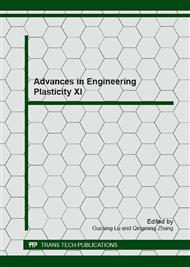p.211
p.215
p.219
p.223
p.227
p.231
p.235
p.239
p.243
Application of Indentation Size Effect in Finite Element Analysis for Friction Simulation
Abstract:
Contact simulation involving asperities was developed by assuming that the deformation by asperities is equivalent to the deformation by an indenter in a hardness test. Consequently, depth dependent flow stress curves were derived from the indentation size effect model from Abu Al-Rub and were used to simulate the influence of the number of asperities involved during contact on the distribution of contact pressure and the value of effective friction coefficient. Results from simulations suggested that multiplying the number of asperities in contact, when the size of the asperities is comparable to the size of the apparent contact, is not followed by proportional multiplication of the reaction forces. The competing phenomena observed in the simulation are then proposed as an explanation to friction size effect occurring in microforming.
Info:
Periodical:
Pages:
227-230
Citation:
Online since:
January 2013
Authors:
Keywords:
Price:
Сopyright:
© 2013 Trans Tech Publications Ltd. All Rights Reserved
Share:
Citation:


